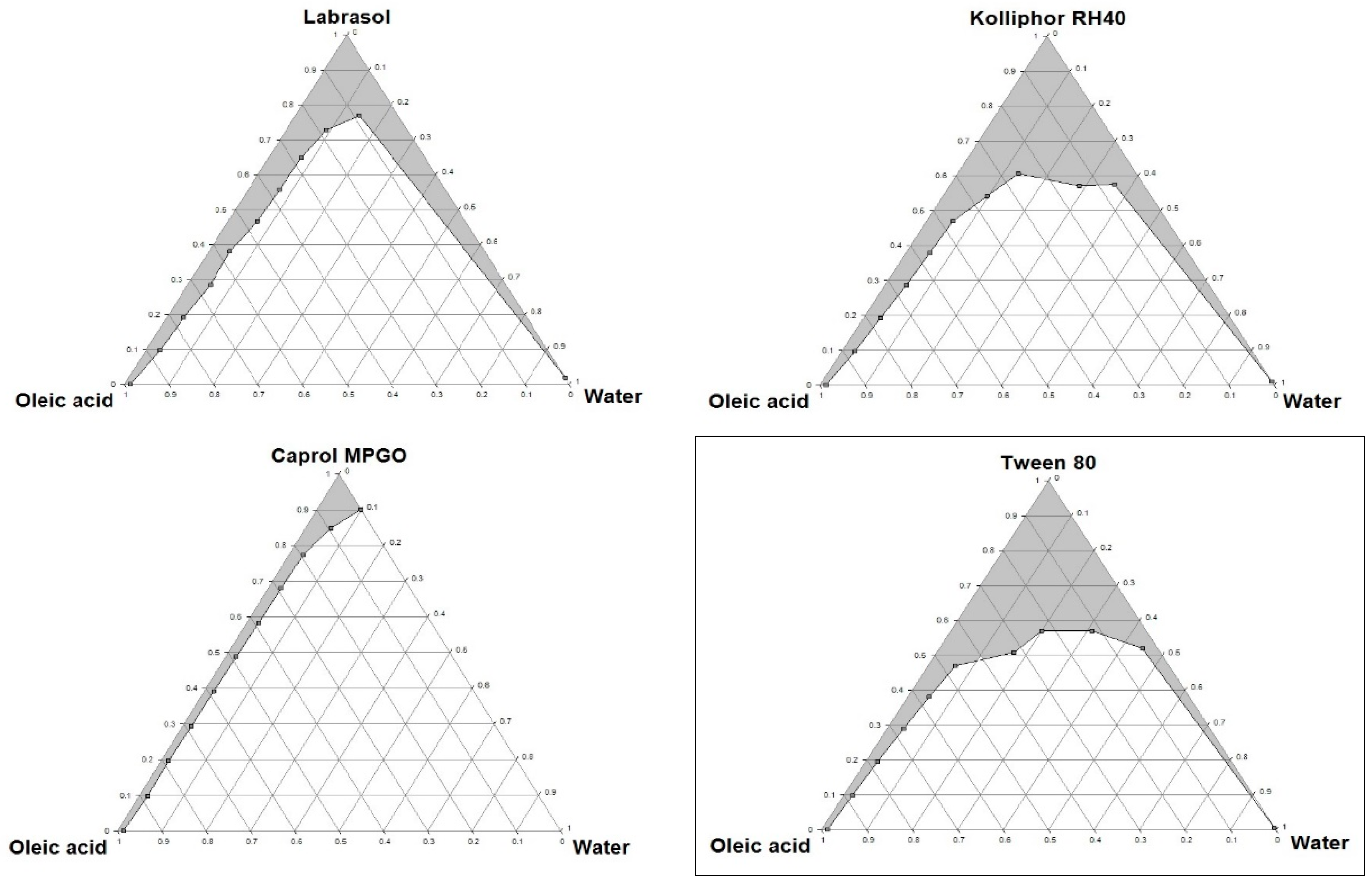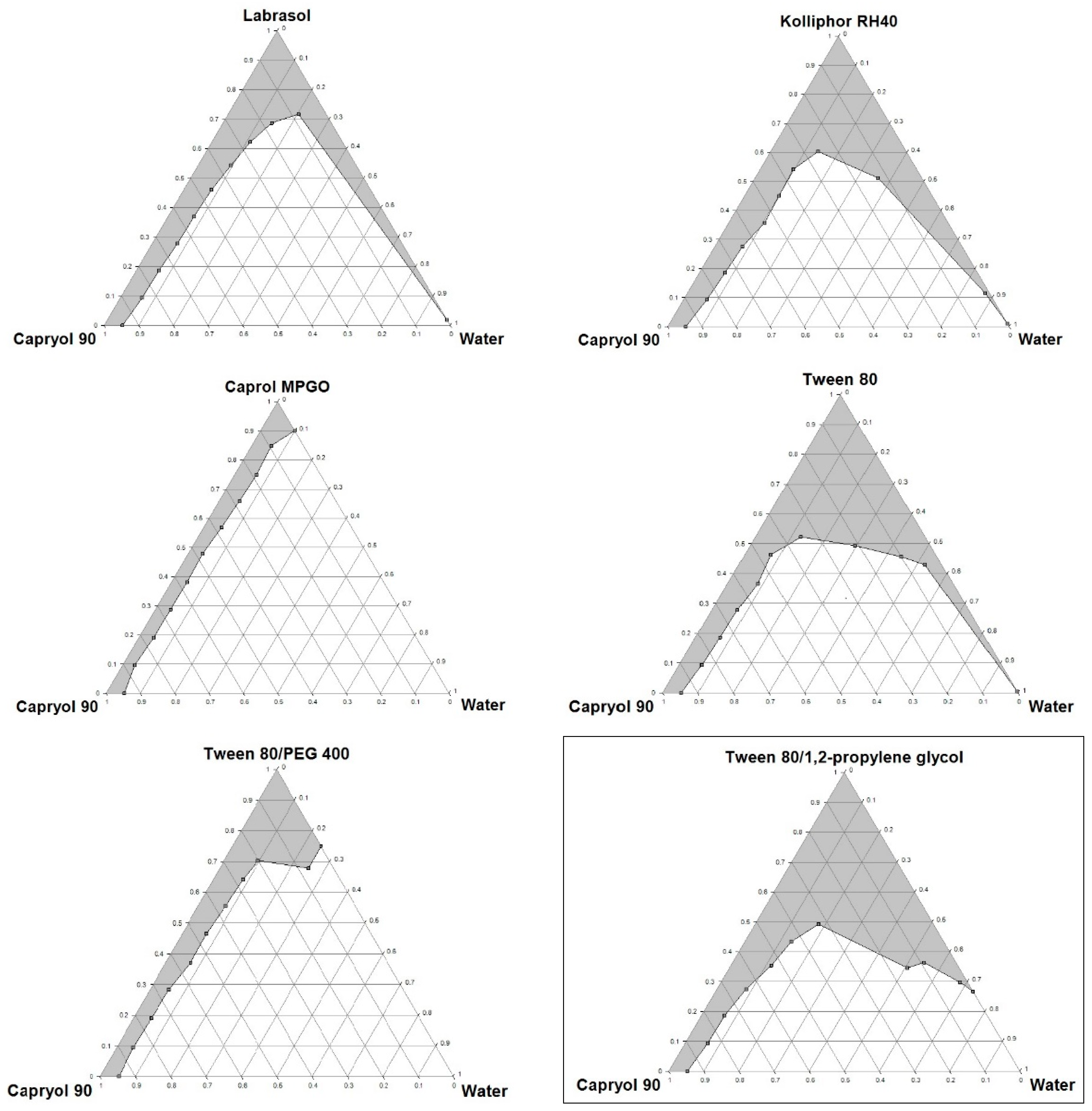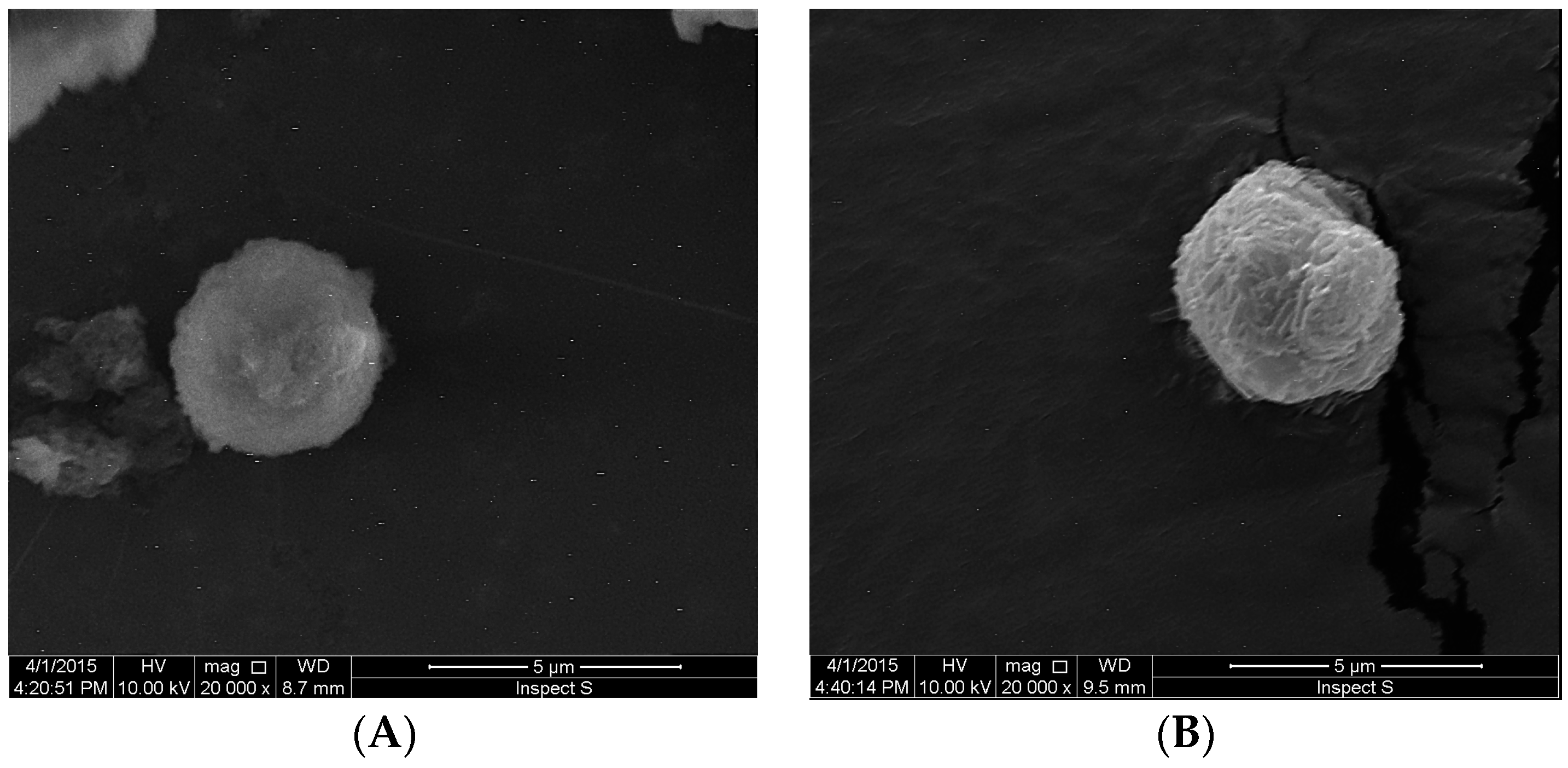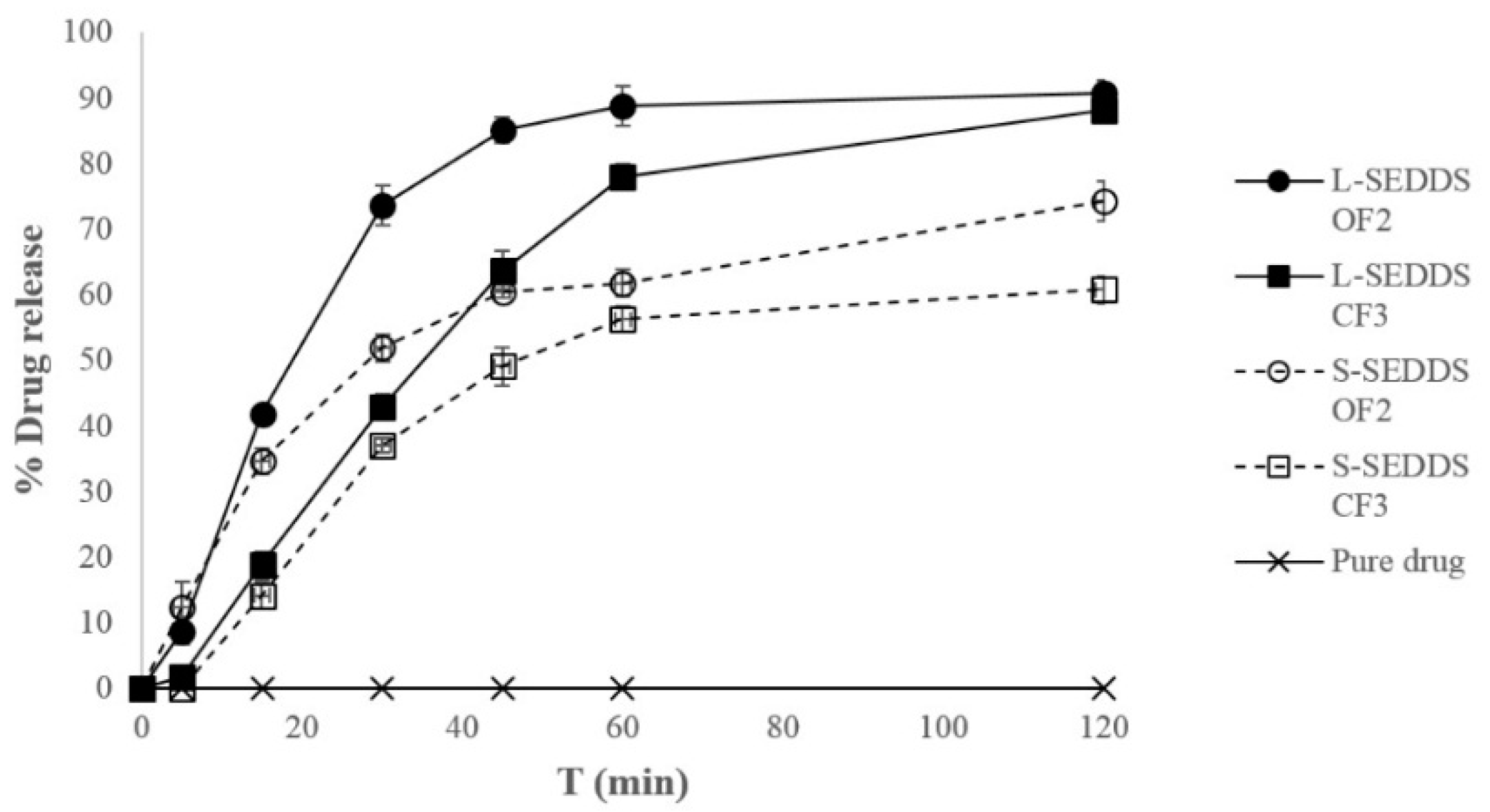Development and Evaluation of Liquid and Solid Self-Emulsifying Drug Delivery Systems for Atorvastatin
Abstract
:1. Introduction
2. Results and Discussion
2.1. Solubility of Atorvastatin (ATR)
| Solvent | Solubility (mg/mL) | Solvent | Solubility (mg/mL) |
|---|---|---|---|
| (A) Oil | Caprol PGE-860 | 13.25 ± 0.48 | |
| Almond oil | 2.82 ± 0.11 | Kolliphor RH40 | 29.67 ± 0.30 |
| Capryol 90 | 14.91 ± 0.34 | Labrafil M19944CS | 2.80 ± 0.06 |
| Captex 200P | 0.23 ± 0.01 | Labrasol | 33.31 ± 0.43 |
| Castor oil | 2.32 ± 0.10 | Lauroglycol FCC | 1.85 ± 0.06 |
| Linseed oil | 0.29 ± 0.01 | Span 20 | 14.69 ± 0.28 |
| Miglyol 812 | 0.89 ± 0.05 | Tween 20 | 13.28 ± 0.08 |
| Oleic acid | 6.50 ± 0.21 | Tween 60 | 17.91 ± 0.63 |
| Rapeseed oil | 1.32 ± 0.07 | Tween 80 | 18.53 ± 0.46 |
| Soja oil | 1.05 ± 0.04 | (C) Co-surfactant | |
| (B) Surfactant | 1,2-propylene glycol | >1 g | |
| Caprol MPGO | 29.83 ± 0.87 | PEG 400 | 34.04 ± 1.21 |
2.2. Pseudoternary Phase Diagrams



| Formulation Code | Oleic Acid (%) | Tween 80 (%) | Formulation Code | Capryol 90 (%) | Tween 80/1,2-Propylene Glycol (1:1) (%) |
|---|---|---|---|---|---|
| OF1 * | 5 | 95 | CF1 ** | 5 | 95 |
| OF2 * | 10 | 90 | CF2 ** | 10 | 90 |
| OF3 * | 15 | 85 | CF3 ** | 15 | 85 |
| OF4 * | 20 | 80 | CF4 ** | 20 | 80 |
| OF5 * | 25 | 75 | CF5 ** | 25 | 75 |
| OF6 * | 30 | 70 | CF6 ** | 30 | 70 |
| OF7 * | 35 | 65 | CF7 ** | 35 | 65 |
| OF8 * | 40 | 60 | CF8 ** | 40 | 60 |
| OF9 * | 45 | 55 | CF9 ** | 45 | 55 |
| OF10 * | 50 | 50 | CF10 ** | 50 | 50 |
2.3. Thermodynamic Stability and Phase Separation Studies
2.4. Emulsification Study
| Formulation | Grade ** | Emulsification Time (s) | Formulation | Grade ** | Emulsification Time (s) |
|---|---|---|---|---|---|
| OF1 | C */A | 75 | CF1 | A | 15 |
| OF2 | D */C | 200 | CF2 | A | 15 |
| OF3 | D */C | 356 | CF3 | B | 20 |
| OF4 | D */C | 420 | CF4 | B | 20 |
| OF5 | D */C | 458 | CF5 | C | 65 |
| OF6 | D */C | 480 | CF6 | C | 65 |
2.5. Determination of Percentage Transmittance, Refractive Index and Turbidity
| Formulation | %T | nD | NTU * | Formulation | %T | nD | NTU * |
|---|---|---|---|---|---|---|---|
| OF1 | 99.7 | 1.334 | 12.8 | CF1 | 99.9 | 1.334 | 0.362 |
| OF2 | 67.1 | 1.334 | 104 | CF2 | 98.8 | 1.334 | 0.452 |
| OF3 | 54.4 | 1.334 | 302 | CF3 | 93.4 | 1.334 | 32.5 |
| OF4 | 48.5 | 1.334 | 473 | CF4 | 77.6 | 1.334 | 77.6 |
| OF5 | 35.0 | 1.334 | 588 | CF5 | 35.6 | 1.334 | 222 |
| OF6 | 23.1 | 1.334 | 476 | CF6 | 3.0 | 1.334 | 591 |
2.6. Droplet Size and Zeta Potential Determination
| Formulation | Particle Size (nm) | Zeta Potential (mV) | Formulation | Particle Size (nm) | Zeta Potential (mV) |
|---|---|---|---|---|---|
| OF1 | 65.16 ± 1.22 | −24.8 ± 1.81 | CF1 | 14.56 ± 0.13 | −2.98 ± 0.43 |
| OF2 | 190.5 ± 1.28 | −32.0 ± 3.20 | CF2 | 76.22 ± 1.19 | −5.39 ± 0.22 |
| OF3 | 224.8 ± 1.36 | −32.8 ± 2.81 | CF3 | 188.1 ± 1.48 | −30.2 ± 1.21 |
| OF4 | 393.6 ± 2.38 | −33.3 ± 3.02 | CF4 | 267.3 ± 0.56 | −31.0 ± 1.01 |
| OF5 | 412.6 ± 2.42 | −37.3 ± 2.76 | CF5 | 297.1 ± 2.53 | −34.6 ± 1.77 |
| OF6 | 447.4 ± 1.52 | −39.7 ± 3.37 | CF6 | 319.6 ± 2.42 | −36.6 ± 2.32 |
2.7. Preparation of S-SEDDS Formulations
| Formulation | Drug Content (the Amount of ATR per 1 g of Formulation) | Encapsulation Efficiency (%) |
|---|---|---|
| L-SEDDS OF2 | 9.46 mg | - |
| L-SEDDS CF3 | 21.78 mg | - |
| S-SEDDS OF2 | 4.64 mg | 52.9 |
| S-SEDDS CF3 | 11.17 mg | 53.6 |

2.8. In Vitro Dissolution Study

3. Experimental Section
3.1. Chemicals
3.2. Solubility Studies
3.3. HPLC Analysis
3.4. Construction of Ternary Phase Diagrams
3.5. Preparation of Liquid SEDDS
3.6. Characterization of Liquid SEDDS
3.6.1. Thermodynamic Stability and Phase Separation Study
3.6.2. Emulsification Study
- Grade A:
- Rapidly forming (within 1 min) emulsion, with a clear or bluish appearance
- Grade B:
- Rapidly forming (within 1 min), slightly less clear emulsion, with a bluish white appearance
- Grade C:
- Fine milky emulsion that formed within 2 min
- Grade D:
- Dull, greyish white emulsion having slightly oily appearance that is slow to emulsify (longer than 2 min)
- Grade E:
- Formulation exhibiting either poor or minimal emulsification with large oil droplets on the surface
3.6.3. Determination of Percentage Transmittance, Refractive Index and Turbidity
3.6.4. Droplet Size and Zeta Potential Analysis
3.6.5. Drug Content in L-SEDDS
3.7. Preparation of Solid SEDDS
3.8. Characterization of Solid SEDDS
3.8.1. Drug Content in S-SEDDS
3.8.2. Morphological Analysis
3.8.3. Droplet Size Determination
3.9. In Vitro Dissolution Study
3.10. Statistical Analysis
4. Conclusions
Acknowledgments
Author Contributions
Conflicts of Interest
References
- Lipinski, C.A. Poor aqueous solubility—An industry wide problem in ADME screening. Am. Pharm. Rev. 2002, 5, 82–85. [Google Scholar]
- Rao, B.P.; Baby, B.; Durgaprasad, Y.; Rames, K.; Rajarajan, S.; Keerthi, B.; Sreedhar, C. Formulation and evaluation of SMEDDS with Capmul MCM for enhanced dissolution rate of valsartan. RGUHS J. Pharm. Sci. 2013, 3, 33–40. [Google Scholar]
- Patel, A.R.; Vavia, P.R. Effect of hydrophilic polymer on solubilization of fenofibrate by cyclodextrin complexation. J. Incl. Phenom. Macrocycl. Chem. 2006, 56, 247–251. [Google Scholar] [CrossRef]
- Vaculikova, E.; Placha, D.; Pisarcik, M.; Peikertova, P.; Dedkova, K.; Devinsky, F.; Jampilek, J. Preparation of risedronate nanoparticles by solvent evaporation technique. Molecules 2014, 19, 17848–17861. [Google Scholar] [CrossRef] [PubMed]
- Karim, F.T.; Kalam, A.; Anwar, R.; Miah, M.M.; Rahman, S.; Islam, A. Preparation and evaluation of SEDDS of simvastatin by in vivo, in vitro and ex vivo technique. Drug Dev. Ind. Pharm. 2014, 20, 1–5. [Google Scholar]
- Salimi, A.; Zadeh, B.S.M.; Hemati, A.; Birgani, S.A. Design and evaluation of self-emulsifying drug delivery system (SEDDS) of carvedilol to improve the oral absorption. Jundishapur J. Nat. Pharm. Prod. 2014, 9, 1–7. [Google Scholar] [CrossRef]
- Saritha, D.; Bose, P.; Nagaraju, R. Formulation and evaluation of self-emulsifying drug delivery system (SEDDS) of ibuprofen. IJPSR 2014, 5, 3511–3519. [Google Scholar]
- Sharma, S.; Bajaj, H.; Bhardwaj, S.; Sharma, A.D.; Singh, R. Development and characterization of self-emulsifying drug delivery system of a poorly water soluble drug using natural oil. Acta Pol. Pharm. 2012, 69, 713–717. [Google Scholar] [PubMed]
- Chopade, V.V.; Chaudhari, P.D. Development and evaluation of self-emulsifying drug delivery system for lornoxicam. IJRDPL 2013, 2, 531–537. [Google Scholar]
- Seo, Y.G.; Kim, D.W.; Cho, K.H.; Yousaf, A.M.; Kim, D.K.; Kim, J.H.; Kim, J.O.; Yong, C.S.; Choi, H.G. Preparation and pharmaceutical evaluation of new tacrolimus-loaded solid self-emulsifying drug delivery system. Arch. Pharm. Res. 2015, 38, 223–228. [Google Scholar] [CrossRef] [PubMed]
- Hanh, N.D.; Mitrevej, A.; Sathirakul, K.; Peunqvicha, P.; Sinchaipanid, N. Development of phyllanthin-loaded self-microemulsifying drug delivery system for oral bioavailability enhancement. Drug Dev. Ind. Pharm. 2015, 41, 207–217. [Google Scholar] [CrossRef] [PubMed]
- Qi, X.; Qin, J.; Ma, N.; Chou, X.; Wu, Z. Solid self-microemulsifying dispersible tablets of celastrol: Formulation development, characterization and bioavailability evaluation. Int. J. Pharm. 2014, 472, 40–47. [Google Scholar] [CrossRef] [PubMed]
- Vergote, G.J.; Vervate, C.; van Driessche, I.; Hoste, S.; de Smedt, S.; Demeester, J.; Jain, R.A.; Ruddy, S.; Remon, J.P. An oral controlled release matrix pellet formulation containing nanocrystalline ketoprofen. Int. J. Pharm. 2001, 219, 81–87. [Google Scholar] [CrossRef]
- Czajkowska-Kośnik, A.; Sznitowska, M.; Mirkowska, K. Self-emulsifying oils for ocular drug delivery. II. In vitro release of indomethacin and hydrocortisone. Acta Pol. Pharm. 2012, 69, 309–317. [Google Scholar] [PubMed]
- Cho, W.; Kim, M.S.; Kim, J.S.; Park, J.; Park, H.J.; Ch, K.H.; Park, J.S.; Hwang, S.J. Optimized formulation of solid self-microemulsifying sirolimus delivery systems. Int. J. Nanomed. 2013, 8, 1673–1682. [Google Scholar]
- Trivedi, K.; Patel, P.V. Development and characterization of liquid and solid self-emulsifying drug delivery system of fexofenadine. J. Pharm. Investig. 2013, 43, 385–394. [Google Scholar] [CrossRef]
- Ravula, A.R.; Nagabandi, V.; Parney, S. Encapsulation of self-emulsifying drug delivery systems (SEDDS) of lercanidipine hydrochloride into hard gelatin capsules. Int. J. Biopharm. 2014, 5, 73–82. [Google Scholar]
- Chen, Y.; Chen, C.; Zheng, J.; Chen, Z.; Shi, Q.; Liu, H. Development of a solid supersaturatable self-emulsifying drug delivery system of docetaxel with improved dissolution and bioavailability. Biol. Pharm. Bull. 2011, 34, 278–286. [Google Scholar] [CrossRef] [PubMed]
- Mahapatra, A.K.; Murthy, P.N.; Swadeep, B.; Prasad, R. Self-emulsifying drug delivery systems (SEDDS): An update from formulation development to therapeutic strategies. Int. J. PharmTech Res. 2014, 6, 545–568. [Google Scholar]
- Parmar, B.; Patel, U.; Bhimani, B.; Sanghavi, K.; Patel, G.; Daslaniya, D. SMEDDS: A dominant dosage form which improve bioavailability. Am. J. PharmTech Res. 2012, 2, 54–72. [Google Scholar]
- Yi, T.; Wan, J.; Xu, H.; Yang, X. A new solid self-microemulsifying formulation prepared by spray-drying to improve the oral bioavailability of poorly water soluble drugs. Eur. J. Pharm. Biopharm. 2008, 70, 439–444. [Google Scholar] [CrossRef] [PubMed]
- Crevar-Sakač, M.; Vujić, Z.; Brborić, J.; Kuntić, V.; Uskoković-Marković, S. An improved HPLC method with the aid of a chemometric protocol: Simultaneous determination of atorvastatin and its metabolites in plasma. Molecules 2013, 18, 2469–2482. [Google Scholar] [CrossRef] [PubMed]
- Corsini, A.; Bellosta, S.; Baetta, R.; Fumagalli, R.; Paoletti, R.; Bernini, F. New insights into the pharmacodynamics and pharmacokinetic properties of statins. Pharmacol. Ther. 1999, 84, 413–428. [Google Scholar] [CrossRef]
- European Pharmacopoeia, 6th ed.Council of Europe: Strasbourg, France, 2007.
- Vaculikova, E.; Grunwaldova, V.; Kral, V.; Dohnal, J.; Jampilek, J. Preparation of candesartan and atorvastatin nanoparticles by solvent evaporation. Molecules 2012, 17, 13221–13234. [Google Scholar] [CrossRef] [PubMed]
- Khan, F.; Islam, M.S.; Roni, M.A.; Jalil, R.U. Systematic development of self-emulsifying drug delivery systems of atorvastatin with improved bioavailability potential. Sci. Pharm. 2012, 80, 1027–1043. [Google Scholar] [CrossRef] [PubMed]
- Kadu, P.J.; Kushare, S.S.; Thacker, D.D.; Gattani, S.G. Enhancement of oral bioavailability of atorvastatin calcium by self-emulsifying drug delivery systems (SEDDS). Pharm. Dev. Technol. 2011, 16, 65–74. [Google Scholar] [CrossRef] [PubMed]
- Chouksey, R.; Pandey, H.; Jain, A.K.; Soni, H.; Saraogi, G.K. Preparation and evaluation of the self-emulsifying drug delivery system containing atorvastatin HMG-CoA inhibitor. Int. J. Pharm. Pharm. Sci. 2011, 3, 147–152. [Google Scholar]
- Shen, H.R.; Zhong, M.K. Preparation and evaluation of self-microemulsifying drug delivery systems (SMEDDS) containing atorvastatin. J. Pharm. Pharmacol. 2006, 58, 1183–1191. [Google Scholar] [CrossRef] [PubMed]
- Talegaonkar, S.; Mustafa, G.; Akhter, S.; Iqbal, Z.I. Design and development of oral oil-in-water nanoemulsion formulation bearing atorvastatin: In vitro sssessment. J. Dispers. Sci. Tech. 2010, 31, 690–701. [Google Scholar] [CrossRef]
- Miryala, V.; Kurakula, M. Self-nano emulsifying drug delivery system (SEDDS) for oral delivery of atorvastatin—Formulation and bioavailability studies. JDDT 2013, 3, 131–142. [Google Scholar]
- Azeem, A.; Rizwan, M.; Ahmad, F.J.; Iqbal, Z.; Khar, R.K.; Aqil, M.; Talegaonkar, S. Nanoemulsion components screening and selection: A technical note. AAPS PharmSciTech 2009, 10, 69–76. [Google Scholar] [CrossRef] [PubMed]
- Kibbe, A.H. Handbook of Pharmaceutical Excipients, 6th ed.; Pharmaceutical Press and American Pharmacists Association: Washington, DC, USA, 2009. [Google Scholar]
- Dixit, A.R.; Rajput, S.J.; Patel, S.G. Preparation and bioavailability assessment of SMEDDS containing valsartan. AAPS PharmSciTech. 2010, 11, 314–321. [Google Scholar] [CrossRef] [PubMed]
- Patel, H.K.; Patel, P.V.; Misan, C.K.; Mehta, D.S.; Patel, M.B. Development and characterization of liquid and solid self-microemulsifying drug delivery system of tacrolimus. Asian J. Pharm. 2012, 6, 204–209. [Google Scholar] [CrossRef]
- Gershanik, T.; Benzeno, S.; Benita, S. Interaction of a self-emulsifying lipid drug delivery system with the inverted rat intestinal mucosa as a function of droplet size and surface charge. Pharm. Res. 1998, 15, 863–869. [Google Scholar] [CrossRef] [PubMed]
- Gupta, A.K.; Mishra, D.K.; Mahajan, S.C. Preparation and in vitro evaluation of self emulsifying drug delivery system of antihypertensive drug valsartan. Int. J. Pharm. Life Sci. 2011, 2, 633–639. [Google Scholar]
- AppaRao, B.; Shivalingam, M.R.; Kishore Reddy, Y.V.; Sunitha, N.; Jyothibasu, T.; Shyam, T. Design and evaluation of sustained release microcapsules containing diclofenac sodium. Int. J. Pharm. Biomed. Res. 2010, 3, 90–93. [Google Scholar]
- Sample Availability: Not available.
© 2015 by the authors. Licensee MDPI, Basel, Switzerland. This article is an open access article distributed under the terms and conditions of the Creative Commons by Attribution (CC-BY) license ( http://creativecommons.org/licenses/by/4.0/).
Share and Cite
Czajkowska-Kośnik, A.; Szekalska, M.; Amelian, A.; Szymańska, E.; Winnicka, K. Development and Evaluation of Liquid and Solid Self-Emulsifying Drug Delivery Systems for Atorvastatin. Molecules 2015, 20, 21010-21022. https://doi.org/10.3390/molecules201219745
Czajkowska-Kośnik A, Szekalska M, Amelian A, Szymańska E, Winnicka K. Development and Evaluation of Liquid and Solid Self-Emulsifying Drug Delivery Systems for Atorvastatin. Molecules. 2015; 20(12):21010-21022. https://doi.org/10.3390/molecules201219745
Chicago/Turabian StyleCzajkowska-Kośnik, Anna, Marta Szekalska, Aleksandra Amelian, Emilia Szymańska, and Katarzyna Winnicka. 2015. "Development and Evaluation of Liquid and Solid Self-Emulsifying Drug Delivery Systems for Atorvastatin" Molecules 20, no. 12: 21010-21022. https://doi.org/10.3390/molecules201219745
APA StyleCzajkowska-Kośnik, A., Szekalska, M., Amelian, A., Szymańska, E., & Winnicka, K. (2015). Development and Evaluation of Liquid and Solid Self-Emulsifying Drug Delivery Systems for Atorvastatin. Molecules, 20(12), 21010-21022. https://doi.org/10.3390/molecules201219745







